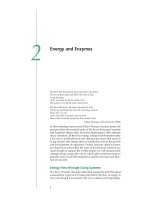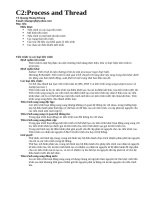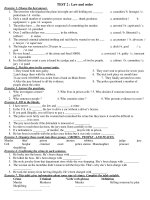2 Shrinkage and Warpage
Bạn đang xem bản rút gọn của tài liệu. Xem và tải ngay bản đầy đủ của tài liệu tại đây (102.7 KB, 8 trang )
2 Shrinkage and Warpage
Mold shrinkage (in-mold shrinkage or moldedpart shrinkage are more accurate terms), although a
volume phenomenon, usually refers to the difference
between the linear dimension of the mold at room temperature and that of the molded part at room temperature within forty-eight hours following ejection.
Warpage, a distortion of the shape of the final injection-molded item, is caused by differential shrinkage; that is, if one area or direction of the article undergoes a different degree of shrinkage than another
area or direction, the part will warp.
Post-mold shrinkage is another common shrinkage term. It refers to any additional shrinkage that occurs after the initial 48-hour period.
Shrinkage and warpage tendencies in molded parts
are influenced by actions taken in each and all of the
manufacturing stages of part design, material selection, tool design, and processing. Subsequent chapters
examine particular causes of shrinkage and warpage
arising in each of these stages. This chapter presents
an overview of shrinkage and warpage phenomena, with
emphasis given to identifying conditions where shrinkage and warpage behave in a regular manner, allowing
for prediction and corrective action.
2.1
In-Mold Shrinkage
In-mold shrinkage tends to respond to changes in
molding conditions as shown below.
An increase in:
Injection pressure
Injection rate
Holding pressure
Holding-pressure time
Melt temperature
Mold temperature
Clamping pressure
Wall thickness
Melt flow rate
Ejection temperature
© Plastics Design Library
Effect on shrinkage:
Decreases (usually)
May be either (minor
effect)
Decreases
Decreases until gate
freeze
May be either
Increases
Usually none; may
decrease
May be either; usually
increases
Decreases
Increases
Cooling time
Decreases
Gate minimum dimension Decreases
Number of gates
Amount of filler
Kind of filler
Mold-open time
(operator break)
Decreases
Decreases
May be either
May be either
Environmental factors may have subtle effects on actual mold or melt temperature:
An increase in:
Effect on shrinkage:
Room temperature
Increases
Humidity
Increases
Air movement
May be either; usually
decreases
Note a prevalence of processing factors in the above
list. Other predictable molding process conditions that
affect shrinkage can be observed on the shop floor. In
particular, use of a molding machine that is too small
may contribute to shrinkage variation through inadequate clamping pressure or plasticizing capacity. A
machine which is too large can cause excessive heat
history and resultant degradation of the material. There
is also an unfortunate tendency of setup workers to
use the maximum available clamping tonnage, even on
small molds. Platens are sometimes bent because high
clamping tonnage is applied to a mold that is very small
compared to the size of the platens. Molds can be damaged by this practice. Variations in the molding cycle
affect the shrinkage. When the molding machine gate
is left open for any reason (while the operator goes to
the lavatory) the next plastic injected into the mold is
hotter and the mold temperature is usually cooler than
the previous shot.
In general, during processing, at the instant a mold
cavity fills, the pressure differential from the gate to
the furthest extremities is at its lowest level. As the
material cools, it typically solidifies first at the farthest point from the gate. This allows the pressure
nearer the gate to be maintained at a higher level until
the gate freezes. This final differential pressure can be
significantly greater than the differential pressure right
after the cavity fills. Gating into the thickest part of
the molding tends to minimize the effects of this differential pressure.
Ch. 2: Shrinkage and Warpage
10
The way in which the mold is filled influences the
direction, degree, and type of molecular orientation in
the molding, especially near the surface. As the material flows into the mold, a spherical volume of material in the melt front is stretched as it advances into an
ellipsoidal shape, as shown in Fig. 2.1.[2] The ellipsoid
formed can be many times greater in length than in
width resulting in almost total straightening of molecular strands and reinforcing fibers in the flow direction.
Dramatic evidence of this shape change can be found
in foamed injection-molded parts. The silvery streaking on the surface is actually a multitude of formerly
spherical bubbles that have elongated (stretched) as
they approach the wall of the mold. An inspection of
this type of part indicates that any single streak is many
times longer than it is wide.
The flowing, stretched plastic is cooled rapidly by
contact with or proximity to the mold wall; the fiber
and molecular orientations are retained. While this is
happening, fresh material flows between the frozen surface layers to create a new melt front. This process
continues until the mold is full. Relaxation and randomization take place rapidly in the melt if it has a low
viscosity, and orientation is therefore highest when the
melt temperature is relatively low. On the other hand,
high melt and mold temperatures give more time for
randomization and can reduce the tendency to warp. A
compromise may be necessary between product quality and production economics because low melt temperatures reduce cycle times.
2.1.1
Determination of Shrinkage
ASTM D955-00 is the American document (related document: European Standard ISO 294-4) that
specifies the standards that are to be used to determine
shrinkage of plastics.[5] It states that the difference in
size of the molded part and the mold is “shrink” and is
affected by a variety of factors. Among the factors causing variation in the actual shrinkage are:
• The size and shape of the part
• The size and length of the runners, gates
and machine nozzle
• The wall thickness of the part
• How the mold works and the effectiveness of the cooling channels in the mold
• The flow patterns within the mold
• The molding machine settings including
holding times and pressures
Minimum shrink will occur when a maximum
amount of material is forced into the mold cavity for
the longest possible time as a result of adequately sized
flow channels, and when pressure is maintained at an
adequately high level until the plastic is thoroughly
hardened. High shrinkage will occur when an inadequate amount of plastic is forced into the mold and
the pressure on the plastic is maintained for too short
an interval of time. High viscosity materials make it
more difficult to maintain adequate mold pressure,
therefore tend to shrink more.
The plastic whose shrinkage is to be determined
may require some special preparation before it is
molded. For example, some thermoplastics absorb
moisture, even from the air, and must be dried before
they are introduced into a molding machine. The sample
should be prepared according to the material
manufacturer’s recommendations, and a record of those
preparations should be included as part of the shrinkage report.
Figure 2.1 The diagram shows how a spherical volume of plastic changes shape as it flows into a mold. This is one of the
mechanisms that cause fiber and molecular orientation.[2] (Reproduced by permission of Oxford Science.)
Ch. 2: Shrinkage and Warpage
© Plastics Design Library
11
The cavity size for measuring shrink parallel to
the flow of the material will normally be 12.7 by 127
mm (1/2 × 5 in.) with a thickness of 3.2 mm (1/8 in.).
The gate will be at one end and normally be 6.4 mm
(1/4 in.) in width by 3.2 mm (1/8 in.) in depth. If the
test mold and gate vary from the above for any
reason, the variance must be included in the test report. When shrinkage in both directions, parallel to and
perpendicular to the flow, are to be determined, the
mold will normally have a cavity 102 mm (4 in.) in
diameter by 3.2 mm (1/8 in.) in thickness, edge-gated
12.7 mm (1/2 in.) in width by 3.2 mm (1/8 in.) in depth.
These molds produce test specimens that can be
measured to determine the appropriate shrink. For
shrinkage parallel to the flow, the long bar will be used
and its length measured and compared to the mold.
For diametral shrinkage, across and along the flow,
the disk produced by the mold will be measured and
compared to the mold both from the gate to the opposite side and in a direction perpendicular to the first
measurement.
The proper procedure to determine the shrink of
the plastic sample is to mold at least five good parts
under proper molding conditions as agreed upon by
the plastic supplier and end user. In the absence of
recommended or agreed molding conditions, ASTM
D955-00 recommends a procedure to achieve good
molding conditions. ASTM Practice D1897 should be
used as a guide for molding conditions. The molding
machine should be of such a size that the sample parts
being molded use about one-half to three-quarters of
the capacity of the injection unit. (Too large a machine
will develop excessive heat history and too small a machine will not produce consistent results.) After the
samples are molded, the length of the bar cavity or the
diameter of the disk cavity is measured to the nearest
0.001 in. (0.02 mm).
The shrink factor is determined by measuring the
test cavity and the piece molded therein, subtracting
the length of the part from the length of the cavity, and
dividing that result by the length of the cavity. The
measurements should be made as soon as the sample
part has cooled to laboratory temperature and again
after forty-eight hours. Measurements of five (or more)
samples should be averaged. The shrinkage should be
expressed in inches per inch of length or millimeters
per millimeter of length (the values should be identical). Any material preparations made before molding
and all molding conditions should be included in the
report.
© Plastics Design Library
2.1.2
Molded-in Stress
Changes in molding conditions that reduce shrinkage usually increase molded-in stress. Mechanical properties depend directly upon the relationship between
the axis of orientation of the plastic molecules and the
axis of mechanical stress upon these molecules. Reversible properties, such as modulus and stiffness, increase in the direction of orientation because stress
along the axis of the molecules is applied against the
strong covalent bonds within the molecules, whereas
perpendicular stress is applied only against the weak
secondary forces between the molecules. Therefore, in
the direction perpendicular to the axis of orientation,
modulus decreases and flexibility increases. These effects are important to the toughness and flexibility of
most films and all fibers.
Ultimate tensile strength generally increases in the
direction of flow or stretch and decreases in the perpendicular direction. Changes in strength also relate to
possible existing stress concentrations (such as microscopic or submicroscopic flaws) that may develop parallel to the axis of orientation. When stress is applied
perpendicularly to the axis of orientation, it tends to
pull the flaws open, but when stress is applied along
the orientation axis, it does not. Moderate orientation,
particularly in rigid amorphous plastics like polystyrene (PS), increases ductility and ultimate elongation
in the orientation direction and decreases them in the
transverse direction. High degrees of orientation of
ductile plastics can have the opposite effect by using
up most of a plastic’s inherent extensibility.
Biaxial orientation (BO) increases impact strength
significantly, making BO very desirable in most packaging films. With monoaxial (uniaxial) orientation, impact strength increases in the direction of stretch; the
material’s ability to withstand transverse impact is very
weak and it usually breaks into bundles of fibers when
the impact strength is tested. These impact results can
be related to the area under the tensile stress-strain
curves; the BO film has a much larger area under the
curve that can be used as a measure of toughness.
The mechanical properties of reinforced plastic
(RP) are even more affected by fiber orientation. A
major advantage of using RPs is the design engineer’s
ability to maximize directional properties; they can be
isotropic, orthotropic, anisotropic, etc. Basic design
theories of combining actions of plastic and reinforcements have been developed and used successfully since
the 1940s, based originally on work with wood-fiber
structures.
Ch. 2: Shrinkage and Warpage
12
As an example, woven fabrics that are generally
bidirectional at 0° and 90° angles contribute to the
mechanical strength at those angles. The rotation of
alternate layers of fabric to a lay-up of 0°, +45°, 90°,
and -45° alignments reduces maximum properties in
the primary directions, but increases them in the +45°
and -45° directions. Different fabric patterns are used
to develop different property performances.
Injection molding of RPs causes some inherent
orientation of the reinforcing fibers. The orientation
increases the difference in strength and shrinkage between the flow and transverse directions. As melted,
the molecules of a polymer are randomly oriented and
intermixed so that strands of one molecule cross and
intermix with the strands of many other molecules. As
the material flows under the influence of the injection
molding machine, the high viscosity of the polymer
causes laminar flow to develop and, as a result, tends
to disentangle the molecules and orient them in the direction of flow. The greatest amount of this type of
orientation takes place in restricted areas such as gates
where very high shear rates are found. As the material
spreads into the mold from the gate, some additional
reorientation takes place. Turbulence and Brownian
randomization can reduce this orientation somewhat,
although some of the extreme orientation triggered by
the gate will be retained in the direction of flow.
When the material contains short glass fibers or
other reinforcements, their orientation will also be determined by the flow pattern. Figure 2.2 shows a sec-
tion through an injection-molded part made from glassreinforced polypropylene. Near the surface, the fibers
are oriented predominantly in the flow direction, while
in the central region they are randomly oriented.[2]
2.2
Warpage
Warpage causes a part to bend or twist out of shape
and alters not only the dimensions but also the contours and angles of the part. This is more readily noticed in large- and flat-molded articles and, though
undesirable in any molding, is particularly objectionable in such items as container covers, closures, or drain
boards. Warpage is related to the phenomenon of material shrinkage. It results when differential or nonuniform shrinkage occurs within a part.
Some nonuniform shrinkage results from poor part
or tool design. Part wall-thickness and geometry are
major design factors. Some causes of warpage are dissimilar wall sections, gating in a thin section of a part,
placing the sprue incorrectly (especially in sprue-gated
parts), or cores that cause weld lines. Computer-aided
process simulation software packages can be used by
the part designer to optimize the part and tool designs,
and minimize the potential for shrinkage and warpage
long before the mold is built or the part is processed.
Such software tools are examined in Ch. 9. However,
it cannot be overemphasized that an experienced mold
designer and builder will recognize potential hazards
Figure 2.2 Section parallel to the flow direction through a glass-reinforced polypropylene injection molding shows that the short
fibers near the surface are oriented parallel to the flow direction while those in the central region tend to be transverse to flow.[2]
(Reprinted by permission of Oxford Science.)
Ch. 2: Shrinkage and Warpage
© Plastics Design Library
13
in a part or mold design and do everything possible to
avoid molding problems. Computer-aided process
simulation results can be worse than those of guesses
made by experienced mold builders. An inexperienced
software user can use the simulation program inappropriately and produce misleading results. In other
words, it is a mistake to rely on computer-aided process simulations unless the operator is very experienced
and has good references. The human factor is a major
phenomenological element influencing part shrinkage
and tool design.
Some nonuniform shrinkage is a result of the
choice of material. Some plastics, particularly the semicrystalline ones , have anisotropic shrinkage characteristics. Amorphous thermoplastics are less prone
to warpage than crystalline resins. Semicrystalline
materials naturally shrink more than amorphous materials because the crystals formed during cooling take
up less volume than the unoriented (amorphous) molecules that exist during the melted phase. While high
shrinkage alone does not cause warpage, it increases
the probability that warpage will occur. All plastic
molecules tend to orient in the direction of flow, but
the orientation of semicrystalline materials leads to
anisotropic shrinking. When the molecules are oriented
in the direction of flow, they tend to stack into the crystal
form with the molecular fibers parallel to the direction
of flow. There is little change in length along the fibers, but the fibers nestle together and shrink more
across the direction of flow. This usually results in
greater shrinkage across the flow direction. However
there is a greater tendency in some materials, especially acetal and nylon 66, for the fibers to fold back
on themselves as they crystallize, which increases the
shrink in the flow direction. Flow/cross-flow shrinkage differences tend to become more significant as the
average molecular weight of the polymer increases.
Some nonuniform in-mold shrinkage is due to packing-rate differences and other processing factors. If a
part has molded-in stresses, the stresses force the part
to try to assume its natural or relaxed state. One challenge for the molder, and it is often a significant problem, is to mold the part in such a manner that the
molded-in stresses are minimized. The common causes
of molded-in stresses are uneven cooling, a melt temperature that is too low, and excessive injection pressure. Orientation is increased with increasing fill rates,
decreasing mold or melt temperature, decreasing wall
sections, and converging (as opposed to diverging) flow.
Diverging flow can be represented by a disk gated in
the center. Converging flow would occur in a tapered
rod or wedge shape that is gated on the large end.
© Plastics Design Library
Nonuniform mold shrinkage behavior is an undesirable phenomenon in injection molding since it can
lead to the following:
• Distortions of the finished part (warpage)
• Difficulties in hitting the target dimensions
• Higher internal stress levels
2.2.1
Common Causes of Nonuniform Shrinkage
Shrinkage differentials may be due to any of the
following conditions.
Differential Orientation. In general, oriented material with molecules or fibers aligned or parallel shrinks
in a more anisotropic manner than unoriented material. The degree of orientation imparted to the melt during the mold filling process has a large influence on the
shrinkage exhibited by the plastic material. During mold
filling, the polymer molecules undergo a stretching that
results in molecular orientation and anisotropic shrinkage behavior. Natural, unfilled plastic materials tend
to shrink more along the direction of flow (in-flow
shrinkage) compared to the direction perpendicular to
flow (cross-flow shrinkage), while the shrinkage behavior of reinforced materials is restricted along the
direction of fiber orientation. In general, mold shrinkage will tend to be more isotropic when the degree of
orientation imparted to the melt during mold filling is
minimized, and when favorable conditions for molecular relaxation exist.
Differential Crystallinity. For semicrystalline materials, if some part of the mold cools at a slower rate,
that area will have higher crystalline content and, hence,
higher shrinkage. This is the case for parts with different thicknesses, and for hot spots such as where material is in contact with outside corners of a core or with
core pins.
Differential Cooling. This can occur when the
mold surfaces are at different temperatures, as they
frequently are around core pins, inside and outside mold
corners, near gates, and where there are section thickness variations. Hot spots cause problems in two ways:
with added crystallinity, and with a longer/later cooling time. (The last area to cool acts as if it were shrinking more.)
Material Characteristics. Copolymers are better
than homopolymers at resisting warpage. Certain
types of fillers reduce overall shrinkage and increase
stiffness.
Ch. 2: Shrinkage and Warpage
14
Differential Thermal Strain. This may be due to geometric effects, that is, where there are section thickness changes, sharp inside corners, or other geometric
conditions that cause variable cooling or unusual orientation. The more abrupt the change, or the greater
the differential cooling rate, the more severe the thermal strain.
Molding Conditions. These can lead to excessive
stresses caused by unusually high or low melt temperature or pressure, or unusually long injection time
or short cycles.
Mold Constraints. Mold constraints can contribute to nonuniform shrinkage. Usually the part is free
to shrink in thickness. It is usually less free to shrink in
length and width due to the geometry of the part. There
may be cores, ribs, or edges that are firmly anchored
so that the part cannot move until it is out of the mold.
2.2.2
Principles of Minimizing Warpage
The difficulty in trying to minimize warping is that
the conditions necessary to do so are sometimes the
opposite of those conditions needed to obtain minimal
shrinkage. For example, highly cooled molds cause
lower average linear shrinkage but encourage warpage,
especially in pieces with high surface/thickness ratios.
Often the methods used to minimize molded-in
stress result in unacceptably high shrink rates. The
best resistance to warpage calls for warm molds, high
material temperatures, low injection pressures, and
short injection/hold times. Minimum shrinkage outside
of the mold requires just the opposite. Therefore the
molder is usually faced with difficult compromises to
minimize both warpage and shrinkage. Warm molds
and high melt temperatures allow more time for the
molded part to “relax” before it solidifies. Low injection pressures minimize the stress caused by high-velocity flow through the gate. Short injection and hold
times minimize packing stress.
Unreinforced materials especially require uniform
wall sections. Sections that vary in thickness result in
nonuniform flow and cooling. Multiple gates can help
maintain uniform cavity pressure which leads to more
uniform shrinkage. As always, the temperature control system must maintain a uniform cooling rate
throughout the part.
When molding with fiber-reinforced materials, the
symmetry of the molded part is of supreme importance.
If the part is not symmetrical, then the flow through
the mold also will not be symmetrical. Consequently,
Ch. 2: Shrinkage and Warpage
the fiber orientation will be irregular which leads to
uneven shrink and resulting warpage. Each weld line
is a potential cause of warping. Therefore, the placement of cores and gates is important. If there are cores
on one side of a molded part that cause weld lines, it
may be necessary to place blind cores on the opposite
side of the part to balance the warp tendency caused
by the required cores and weld lines.
Cooling-related shrinkage differences exist for all
polymers, but are a particular concern for semicrystalline polymers. As the name implies, semicrystalline
polymers are only partially crystalline, with the remainder of the matrix being amorphous. The ability of a
semicrystalline polymer to pack neatly into a crystalline lattice is improved when the polymer is cooled more
slowly. The mold shrinkage that a semicrystalline polymer exhibits will therefore be influenced by the rate of
cooling due to its effect on percent crystallinity (see
also Sec. 6.3). This cooling-rate/percent-crystallinity
relationship also accounts for variations in the crystalline morphology of the material through the thickness
of an injection molded part.
The shrinkage behavior of a semicrystalline polymer is therefore far more complicated than that of an
amorphous polymer. The effect of part thickness on
mold shrinkage is very significant with semicrystalline
polymers. The general type of behavior that can be
expected is shown in Fig. 2.3.
Higher mold shrinkage values can be expected for
semicrystalline polymers when thicker wall sections are
used due to the increase in cooling time (and time for
crystallization to occur) associated with the thicker wall.
Figure 2.3. Relationship of part thickness to shrinkage for
semicrystalline polymers.
© Plastics Design Library
15
This can be a particular concern when molding parts
with variable wall thicknesses. For example, in applications where reinforcing ribs are used to stiffen flat
parts, the ribs are typically thinner than the nominal
wall thickness from which they extend. This practice
limits the size of the sink opposite the rib that is a result of the unavoidably thicker section at the juncture.
However, the slower cooling rate for the nominal wall
and juncture (thicker sections) will lead to an increase
in shrinkage, and the potential for concave warpage in
a direction away from the ribs. Crystal orientation and
shear-induced crystallization also complicate the
shrinkage behavior of semicrystalline polymer.
For example, suppose the outer 1 mm of a 5-mm
thick part tends to shrink by 1% because the outer layer
cools faster, under higher pressure, with less crystallization than the center of the part. Cooling and shrinkage after the gate freezes causes the center of the part
to experience a lower pressure than the walls, which
solidify while the gate is still open and maximum injection pressure exists. The center of the part, cooling
slower and under lower pressure with a resulting greater
percentage of crystallization, tries to shrink by 2%. In
this case, the actual measured shrink would be
3
2
+ 2 = 1.6%
5
5
The outer skin compresses slightly as the core stretches
slightly.
In practice, there is no sharp dividing line between
one shrink rate and another. Rather there is a gradual
change in the “natural” shrink rate from the surface of
the part to the core, and the average shrink for the total
thickness is the result of each infinitesimal layer affecting the layers on either side of it.
Taking this example a step further, if one side of
the mold is cooler than the other side, then the layers
on the cooler side will be thicker than the layers on the
warmer side, and will resist shrink more than the thinner layers. The end result will be that the part will tend
to shrink more on the warmer side. If the part is flat,
this will cause the part to warp with a concave curve
on the warmer side.
Even when the mold cavity walls are uniform in
temperature, asymmetry can cause differential cooling
problems. Consider Fig. 2.4. Any variation in wall
thickness will cause differential cooling rates and a tendency for the part to warp so that the heaviest wall will
be somewhat concave.
© Plastics Design Library
When a part warps after being ejected from the
mold, it assumes its “natural” form by relieving the
unnatural stresses forced upon it while being shaped in
the mold in a viscous state. The problem for the
molder—and it is often a difficult one—is to minimize
the “locked-in” stresses which the item might later “remember,” and relieve them when cooling to room temperature or on later exposure to higher than normal
heat. The locked-in stresses are generated in the mold
by such operating conditions as excessive molding pressures, uneven cooling, or a melt temperature that is too
low, to mention only a few causes.
Usually, a number of plastics can be used to satisfy a particular purpose. Many of the semicrystalline
materials have good lubricity; however, their greater
shrink rate and tendency toward warpage may suggest
that the designer consider using a lower shrink, amorphous material with a lubricant filler. This is especially
important if tight tolerances are a requirement. In some
cases, a change in material may be possible to minimize shrinkage or warpage problems provided that the
material change does not cause the size of the molded
part to be out of tolerance as a result of the change in
shrinkage. Glass-filled polypropylene is increasingly
used to fill requirements formerly filled with so-called
“engineering” grades of plastic. This can be an attractive option if the higher shrink rate of the polypropylene (especially across the direction of flow) does not
cause unacceptable warpage or size problems.
Figure 2.4 In asymmetric parts like these, there will be a
cooling rate differential between thick and thin areas.
Ch. 2: Shrinkage and Warpage
16
2.3
Post-Mold Shrinkage
Cold molds and rapid cycles tend to freeze stresses
in a molded part while reducing its apparent shrinkage. Later, with exposure to time and/or temperature
and moisture, additional shrinkage can occur. Shrinkage that occurs more than forty-eight hours after molding is considered to be post-mold shrinkage. In higher
shrink materials such as acetal and nylon, the postmold shrinkage can be significant. While higher mold
temperatures require longer cycles, cost more, and produce parts with more apparent shrinkage, the total
shrinkage and post-mold shrinkage are less.
Parts molded in the injection molding process are
molded dry. They initially contain virtually no water.
Some materials, especially nylon, absorb moisture from
the environment. Nylon needs water to develop its best
physical characteristics. Dry, it is brittle. Moisture
absorption and size change for several resins are shown
in the appendix entitled “Data,” of this book (and in
reference books such as Modern Plastics Encyclopedia[59] and in literature available from plastics suppliers).
Nylon is an excellent material, but consideration
should be given to any size change when hygroscopic
materials are exposed to moisture in product-service
use. Hygroscopic materials have an affinity for water
to such an extent that they will absorb a significant
percentage of their weight in water. Nylon and the
cellulosics are most vulnerable to size change due to
moisture. If only one side of a hygroscopic material is
Ch. 2: Shrinkage and Warpage
exposed to water, that one side may grow in length to
such an extent that the part warps (bows convex toward the moisture) to a significant degree on the wet
side. Various plastics often absorb water or other liquids to a degree that makes the plastic unsuitable for a
particular application. Even though the moisture absorption of polycarbonate is quite small compared to
nylon, CD discs, which are metallized on only one side,
can bow beyond their tight tolerances. The chemical
resistance of a plastic needs to be matched to whatever
environmental fluid it is likely to encounter. If the supplier states that a plastic is compatible or resistant to a
fluid, that usually means that it absorbs less than 1%
of the fluid. On the other hand, some plastics contain
fluids such as plasticizers that tend to migrate or “boil
off” with time. The loss of fluids usually causes shrinkage and increased brittleness.
Chapter 7 of this volume contains additional information and a discussion in greater depth of the absorption of various liquids. The effect of elevated temperature and its tendency to encourage annealing of
thermoplastic parts and how that affects size change is
presented there. And finally, plastics creep. This means
that if a significant load is placed on a plastic part, it
will move or sag. The longer the load is applied, the
more the plastic part will deflect. This characteristic
of plastics is often overlooked and has been a major
cause of component failure. More often than not, when
a plastic part fails, creep is directly or indirectly involved in the failure, and the failure is a result of bad
design. Unfortunately, the plastic gets the blame and
not the deficient design.
© Plastics Design Library









